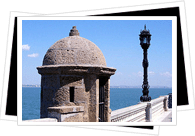 Cadiz was founded about 1,100 years B.C., which makes it not only the oldest city in Europe and but also probably in the western world. Cadiz enjoyed a long (over 3,000 years!) and illustrious history and has been home to many cultures and civilizations – Phoenicians, Greek, Visigoth, Roman, Moorish, Spanish, to name a few.
Cadiz was founded about 1,100 years B.C., which makes it not only the oldest city in Europe and but also probably in the western world. Cadiz enjoyed a long (over 3,000 years!) and illustrious history and has been home to many cultures and civilizations – Phoenicians, Greek, Visigoth, Roman, Moorish, Spanish, to name a few.
The Phoenicians first settled in this area and called it “Gadir”, which means “enclosure” – most likely because of the fact that the city is almost completely surrounded by water. The Phoenicians initially founded the city as a trading post.
Then, in 500 B.C., Carthage came and conquered the city, using it as Hannibal’s base of operations in his quest to conquer southern Iberia. Then came Scipio Africanus and the Romans. Under Roman rule, “Gadir” became “Gades” – “Augusta Urbs Julia Gaditana”, if you will. It highly prospered as a naval base. However, Roman power began to decline, and along with it, Gades’ role as a viable commercial base. During the 5th Century, the Visigoths conquered the city and called it “Qadis”. Much of the city was destroyed during the conquest. In 1262, the Moors were ousted by Alphonso X “The Wise”.
Cadiz’ rise again began during the 15th century, when the Catholic Kings placed the city under the Spanish Crown. Its role as a port city reached its peak then. This is where Christopher Columbus set sail on his journey to discover America. It is also during the 15th century that Felipe II ordered that walls surrounding the city be built. This was after Cadiz suffered attacks from the British, led by Sir Francis Drake, Lord Charles Howard, Admiral Robert Blake and Sir George Rooke James.
The first Liberal Constitution was drafted and proclaimed in Cadiz. Also, Cadiz stood as the capital of Spain for three years (1810 to 1813). It was during this time that Cadiz once again flourished as a cosmopolitan city, when it traded with the colonies. Indeed, the 18th century is the “golden era” for Cadiz.
The 18th and 19th centuries were marked by a period of rebuilding and consolidating; during this era, most of the monuments of Cadiz were built. Indeed, you can see many fine examples architecture constructed during this epoch.
All in all, Cadiz’ history is laden with stories of a people who had brave and generous spirits; this spirit lives on even today. Cadiz remains a city that is both cosmopolitan and open.
Internet Guide:
Cadiz Guide